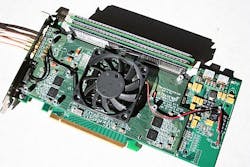BERKELEY, Calif., 4 Nov. 2012. Ultraview Corp. in Berkeley, Calif., is introducing the ULTRADYNE16-250Mx2AVE-8GB-50T/155T and ULTRADYNE16-250x4AVE-8GB-50T/155T 16-bit 4-channel 250-megasample-per-second A/D converter boards for military, medical, and scientific applications in which signals on several time-aligned channels need to be observed with high signal-to-noise ratio.
Target applications for the A/D converter boards include radar, ultrasound, time-of-flight imaging, spectroscopy, communications systems, and antenna testing, Ultraview officials say.
Based on a hardware averaging engine with near-zero dead-time that is implemented in the board's Xilinx FPGA, the boards each can average repetitive signal strings as many as 1 million times with record lengths to 16384 samples (-50T model) and 262144-samples (-155T model) uninterruptedly.
The precise repetitive summing of each string of samples onto a running 32-bit average can be triggered by any one of three software-selectable triggering mechanisms.
One triggering mechanism is a TTL input, with selectable -/+ slope, causes waveforms to be acquired or added to a running average. The second is a software slider-adjustable level on the incoming signal waveform on any of the 4 channels, with + or -- slope, enabling scope-like triggering, with pre-trigger, on a given place on a repeating waveform.
The third triggering mechanism is a heterodyning trigger input that implements triggering on the difference frequency between this input and the sampling clock frequency for uses such as time-of-flight imaging systems, radar and pulsed spectroscopy.
These kinds of applications can repeat transmit or stimulus waveforms M-times per second and the A/D samples data at a rate of N samples per second. The ULTRADYNE16 will automatically acquire and/or average complete waveforms that repeat M minus N times per second.
In addition to their averaging and triggering modes, which include pre-triggering capability, the boards also are high dynamic range general purpose high speed data acquisition boards, each with eight gigabytes of memory, large channel counts, and continuous transfers to the host system at speeds to 1.4 gigabytes per second.
All models include Windows 7/8 driver packages, as well as LabVIEW control panel for Windows. 64-bit Linux 6.2 drivers and command line user programs are also included.
For more information contact UltraView online at www.ultraviewcorp.com.



